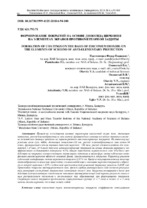| dc.contributor.author | Пантелеенко, Ф. И. | |
| dc.contributor.author | Оковитый, В. А. | |
| dc.contributor.author | Оковитый, В. В. | |
| dc.contributor.author | Асташинский, В. М. | |
| dc.contributor.author | Углов, В. В. | |
| dc.coverage.spatial | Кемерово | ru |
| dc.date.accessioned | 2024-04-02T09:31:59Z | |
| dc.date.available | 2024-04-02T09:31:59Z | |
| dc.date.issued | 2018 | |
| dc.identifier.citation | Формирование покрытий на основе диоксида циркония на элементах экранов противометеорной защиты = Formation of coatings on the basis of zirconium dioxide on the elements of screens of anti-elementary protection / Ф. И. Пантелеенко [и др.] // Вестник Кузбасского государственного технического университета. – 2018. – № 6. – С. 94-101. | ru |
| dc.identifier.uri | https://rep.bntu.by/handle/data/141627 | |
| dc.description.abstract | Проведены исследования влияния параметров плазменной струи (ток, дистанция напыления, расход плазмообразующего газа азота), фракционного состава исходного порошка и степени охлаждения сжатым воздухом на характеристики антиметеоритных покрытий. На оптимальных режимах (ток дуги -600А; дистанция напыления-110 мм; расход плазмообразующего газа азота-50 л/мин; фракционный состав порошка диоксида циркония <50 мкм; расход сжатого воздуха для охлаждения 1 м3/мин; р=4 атм) получено антиметеоритных покрытий на основе диоксида циркония с коэффициентом использования материала -62%; общую пористость керамического слоя -6%.После воздействия на покрытие компрессионными плазменными потоками в атмосфере азота кубическая модификация оксида циркония является основной фазой, присутствующей в покрытии. Параметр решетки кубической модификации оксида циркония составляет 0,5174 нм. Ввиду использования азота в качестве плазмообразующего вещества происходит его взаимодействие с атомами циркония покрытия и образуется нитрид циркония с-ZrN с кубической кристаллической решеткой (параметр решетки 0,4580 нм). Происходит плавление приповерхностного слоя, причем глубина расплавленного слоя согласно результатам растровой электронной микроскопии составляет около 8 мкм. Закристаллизовавшийся после воздействия компрессионными плазменными потоками приповерхностный слой характеризуется гомогенным распределением элементов и отсутствием пор, образованных при формировании покрытия. Структура самого покрытия представлена совокупностью крупных (5 - 7 мкм) и мелких (1 - 2 мкм) частиц оксида циркония, спеченных между собой. | ru |
| dc.language.iso | ru | ru |
| dc.publisher | КузГТУ | ru |
| dc.title | Формирование покрытий на основе диоксида циркония на элементах экранов противометеорной защиты | ru |
| dc.title.alternative | Formation of coatings on the basis of zirconium dioxide on the elements of screens of anti-elementary protection | ru |
| dc.type | Article | ru |
| local.description.annotation | The article contains results research of influence of parameters a plasma jet (current, spraying distance, plasma gas consumption) fractional composition of the starting powder and the degree of cooling compressed air on anti-meteoric coating characteristics. We get an anti-meteoric coatings based on zirconia at optimum modes (arc current -600A; spray distance of 110 mm; plasma gas consumption 50 l/min; fractional composition of zirconia powder <50 microns; air consumption for cooling 1 m3/min; p = 4 bar) with materials utilization rate -62%, total porosity of the ceramic layer -6%. Cubic zirconia modification is the main phase present in the coating after exposure to coating compression plasma flows in a nitrogen atmosphere. The lattice parameter of cubic zirconia is 0.5174 nm. Because of the use of nitrogen as the plasma substance is its interaction with the atoms and zirconium coating is formed from zirconia nitride-ZrN with a cubic crystal lattice (lattice parameter 0.4580 nm). The melting of the surface layer occurs, and the depth of the molten layer, according to a scanning electron microscope is about 8 microns. Crystallized surface layer after exposure to compression plasma flows is characterized by a homogeneous distribution of the elements and the absence of pores formed in the formation of the coating. The structure of the coating represented by a set of large (5 - 7 microns) and small (1 - 2 microns) of zirconium oxide particles sintered together. | ru |

